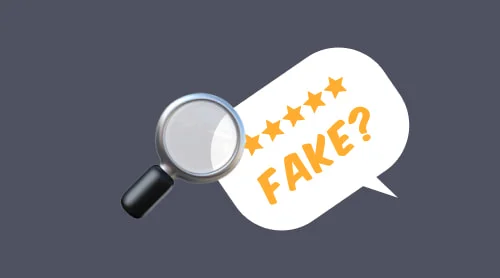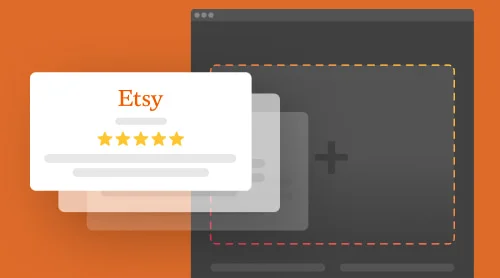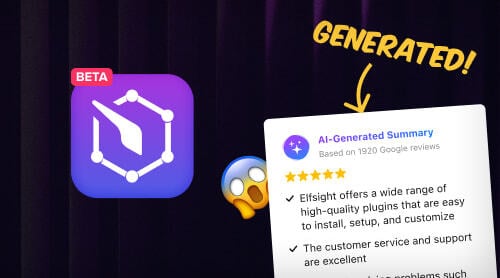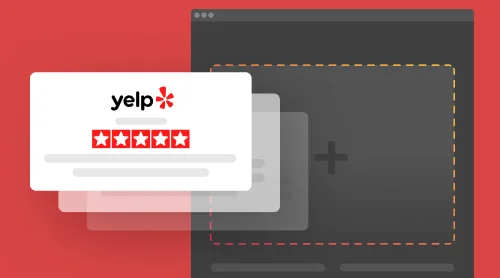Why Are There So Many Fake Reviews?
Big companies like Google, TripAdvisor, Amazon, and Yelp can’t catch up with the massive amount of fake reviews posted every single day. Even with the superior monitoring system, the number of fake reviews is growing faster than any team or review checker program is prepared to handle the situation.
Based on 2023 TripAdvisor’s Review Transparency Report, the company has manually human-moderated around 2.3 million review submissions out of 30.2 million in the previous year. That comes down to only 6.9%, and still, there were 1.3 million fake reviews detected and removed, with 72% of these caught before ever being posted.
Yelp doesn’t directly call reviews fake but provides some analytics about removing reviews for policy violations, such as receiving payments, being a competitor, promoting other businesses, talking about someone else’s experiences, etc. This is what they have discovered:
2022 Yelp’s Trust and Safety Report says the moderators have removed over 26 thousand out of 21 million submitted reviews due to the content policy violation and declined more than 38 thousand new business pages. Plus, after the Media Attention Alerts, 74,500+ reviews were deleted for abnormal activity.
Although they’ve made strides to raise awareness and start bringing up this fake reviews topic, we can’t help but wonder if their actions are that effective at this point. So, the question to explore is this: how can we protect ourselves from fake reviews based on common knowledge and not become the victims of an online scam?
How to Spot Fake Reviews Online?
If there was only one way to find out which company and brand posts or does not post fake reviews or be 100% certain in not legitimacy, then perhaps we wouldn’t be having this conversation now. But the Internet is a place that can lack not only finer intricacies but information hygiene. After all, it has used our subconscious need to trust the subjective experience of usual fellows like you and me and turned this against us.
But what can we learn from that? Why do these companies post fake reviews? And what are the red flags that have to be spotted to stay warned? Let’s check them out together.
1. Reviewer’s Name
This is something you should be concerned about. The first spotted pattern is that the reviewer’s name contains one letter with a period as a middle name. It doesn’t come naturally to hide the middle name while being willing to expose other personal details. These examples can be clearly seen in the Google Reviews:
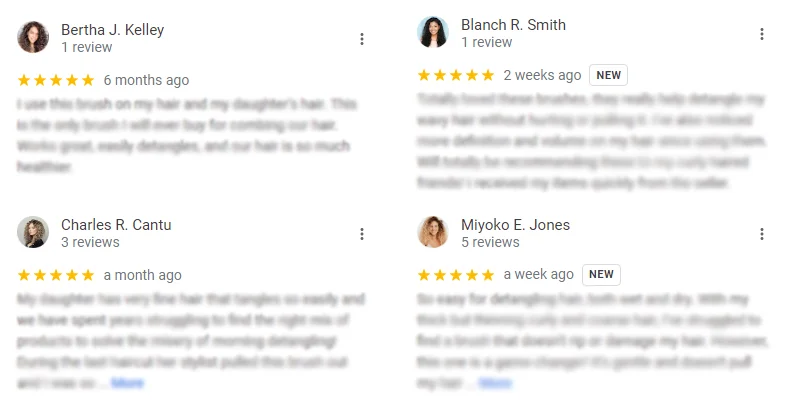
Besides, take a moment to look at the first and last names in the reviews on Google, TripAdvisor, or Amazon. Does the combination sound too generic and commonly used, like John Smith or Jane Doe, or does a person’s name contain tons of numbers and mixed letters? Then it is most likely to be fake.
2. Profile Picture
The profile pictures in the spotted reviews are too good to be true or remind you of someone. They are polished, professionally taken by a photographer with perfectly set up lighting, minimalistic background, and maybe a bit photoshopped to achieve a flawless look. There are two possibilities:
They are stock images from Freepik, Pexels, and Shutterstock or taken from any other similar resource.
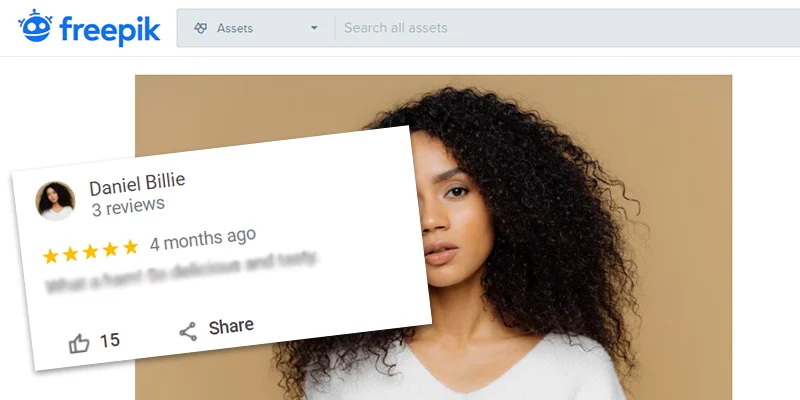
They are actual photos of actors and other artists taken from search engines like Google.

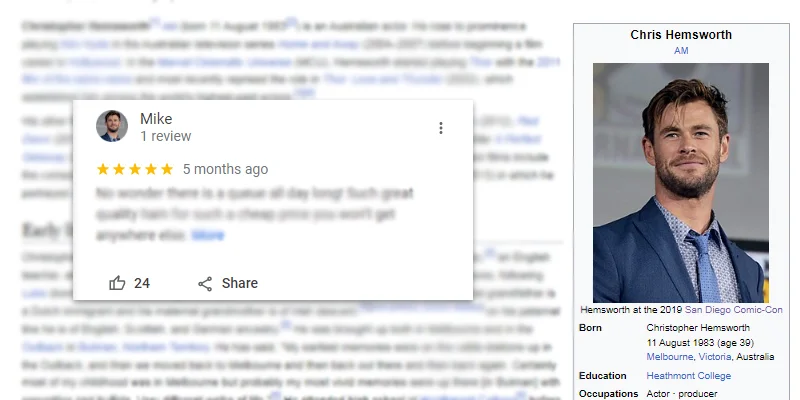
Another nuance that falls down into this category is the repeating profile picture. It appears throughout several reviews or is mentioned for another product, place, or service. Overall, you get the striking feeling that you’ve seen it somewhere. Well, maybe you did. Take these Google reviews as an example:
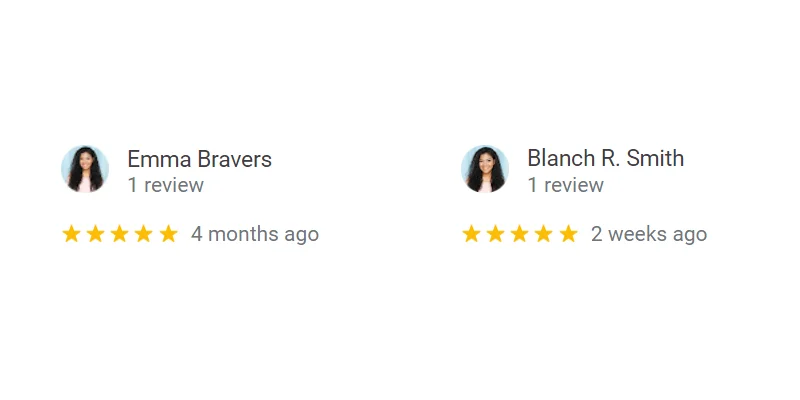
It all leads us to conclude: these reviewers’ accounts on Google, TripAdvisor, Amazon, and Yelp are sure to be fake and bought from scamming third-party sources, the content farms.
3. Reviewer’s Profile History
Another thing to keep in the back of your mind is checking the reviewer’s history and profile details. Does the person spread misinformation by sharing only positive fake reviews with five-star ratings or negative ones with one-star? If the answer is yes, then it already sounds sketchy.
What’s equally important is to take notice of the location in the reviews. If the reviewer wrote a message to the restaurant in Berlin, then appears to be delighted by medical services in the United States and loves their new haircut in Australia in a short period. There are no questions: it may fall into the fake reviews rabbit hole, not only for Google, Yelp, or Amazon but even for TripAdvisor users.
4. Spelling, Grammar, and Reviews Meaning
With this spotted red flag for fake reviews, let’s add some context. Our market is full of content farms, also known as content mills, which are companies or brands that force low-quality fake content with super high speed. Part of what makes them in demand is the fulfillment of the lack of keywords and encouraging hopes to rank higher in search engines. But, as we all know, there is always another side to the coin, and the truth doesn’t sound this good.
Usually, these companies hire non-professional writers from developing countries with low-income economies. When there is nothing wrong with employing these people and giving them a chance for better living conditions, we can’t really ignore the underpayment and absence of fluency in English skills while reading the reviews. So if reviews are released just to be published with a deficiency of grammar and meaningful message, we may address this type of content as being faked and paid for.
The next time you decide to read through the reviews on Amazon or Google, spot for signs like misspellings, grammatical mistakes, and lost track of sense. For example, the person describes unusual positive characteristics not inherent to a product or brings up completely irrelevant details, such as different locations or brand names.
However, excellent grammar and perfectly written positive reviews are also concerning. Unlike the errors mentioned above, this might be too hard to recognize. We already have expectations of an average person with a decent education and set of skills. So when we observe nicely made reviews, doubt questions don’t pop up in our heads. It’s a simple thing: how should we spot this fake info?
Once again, rely on facts and pay attention to details in the reviews, keeping an average person’s image in mind. Is it possible for them to know the head chief of a company? Marketing or selling teams? And any other specifics, words, and phrases mentioned in reviews.
5. Reviews Timeline
Let’s refer to the timestamp when the company or brand receives reviews as another possible sign. You’ve noticed that dozens of positive or negative fake feedback primarily were contributed in one moment. The time gap between posting reviews is small and outlines kind of the same latest information.
And there’s an explanation, and you can find obvious reasons why it might happen with fake reviews. Here are the major differentiations:
- The company releases new products, services, or updates. And it’s trying to promote them using fake reviews.
- The company’s competitor felt the need to push back the brand off the market and used fake reviews to scare potential consumers.
- The company is attempting to recover the overall rating by posting fake reviews with five stars.
The increasingly competitive environment on TripAdvisor, Amazon, and Yelp, paired with an attempt to become a market leader, makes some companies practice dreadful methods to keep the spotlight on them. And sadly, it includes posting fake positive or negative feedback that holds potential risks: losing a good reputation in a blink of an eye. Keep track of the information you consume and check the reviews’ integrity!
6. Too Many Details or Lack of Them in Reviews
Neglecting details in the reviews is not the worst scenario but a suspicious factor causing the unclarity. This type of positive response can be seen as useless most of the time. There is no added valuable fact-checked information to state the quality. Of course, it doesn’t mean you’re definitely encountering fake reviews. But it also doesn’t mark them as real ones.
On the other hand, does the reviewer know too many facts about the product, company, or people who work there? It’s an entirely polarized perspective. In a vast majority of cases, people can observe the product and services from only their experience. They are not trying to add fake positive selling characteristics, specific marketing details, or professional terms in their feedback on TripAdvisor, Amazon, and Yelp.
And seems fair to note that creating an emotional bond in reviews on Google or Amazon is another way of a cheat code. Like the made-up story about the daughter’s hair getting stuck in a brush or a pet that crossed the rainbow bridge. And there was the solution, or how they say the lifesaver — the reviewed product/service.
7. Generic Words, Emotions, and Phrases Are Used in Reviews
If the spotted fake reviews tend to be less descriptive, they might be expressed in one simple sentence with similar phrases, like:
- I recommend.
- The best product.
- It saved my life.
- Great product.
Consider this as the person understood the assignment and didn’t attempt to add layers or compelling details to extend limits in reviews.
Another pattern to spot is overreacting in reviews. The person combines all the excitement, joy, and too much enthusiasm in reviews. Reading this type of response may appear staged if we look behind the scenes. The appeal of real emotions overlaps with an inauthentic context that leads to thinking it is just fake.
Observing reviews containing too many personal pronouns and verbs, it’s one more way to stumble upon a red flag. The need to broadcast trustworthiness in the reviews can play a psychological game with the mind. The more reviewers try to convince users to believe, the more they articulate fake self-centered phrases with lots of actions.
8. High Percentage of Only Positive or Negative Reviews
Probably, you’ve spotted the evidence of these fake reviews on Google, Yelp, Amazon, or TripAdvisor. Instead of considering the full and real picture, there is an absolute star rating. People somewhat enjoy or hate the product, and nothing in between doesn’t seem to exist in all reviews. As displayed in Google:
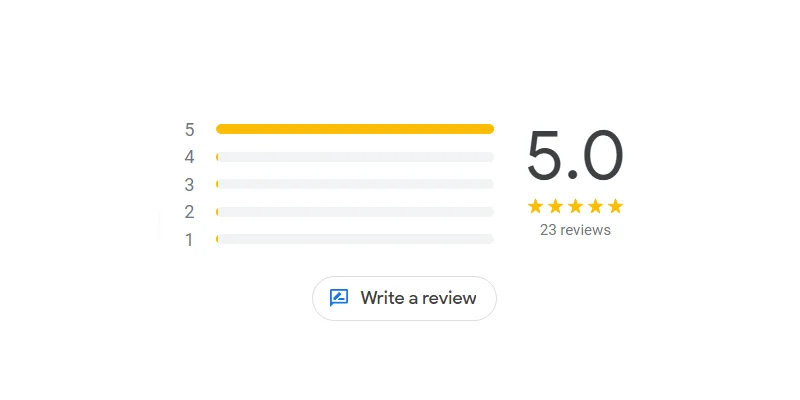
Most of the time, it’s a ringing call to be wiser before making a purchase or visiting a place and not rely upon Google or TripAdvisor reviews. Disliking is an okay experience, and it’s impossible for everyone entirely to love the product/service. Some aspects remain not appealing or suited to the preferences.
The same goes for negatively describing the product in the reviews. Whereas someone may find it a total disaster and wasted money, you can still combat one-star ratings with at least two stars. In this case, maybe a competitor is trying to ruin the reputation of this business by adding fake reviews: who knows?
9. Competing Products and Brands Are Mentioned in Reviews
This is another method to spot fake reviews on Google, Yelp, Amazon, or TripAdvisor. On the promotion subject, it feels strange to mention someone else’s products in reviews in some way. Beyond how good or bad the original product/service is, the reviews section is meant for the companies who offer it.
By letting consumers know about another product and downsizing the positive characteristics of an item in the reviews, these people initially hope to spark the need to search for a better option. So the estimate is fake and not genuine positive feedback.
10. Free Product Mention in Reviews
The tendency to send free products or small gifts in exchange for positive reviews has never faded away. Even though many marketplaces, like Amazon, forbid this and view it as a violation of rules, the shop owners continue to test their luck.
And it serves the purpose well, to be honest. The obligations meet customers’ feelings to be grateful in return. They leave positive reviews on Amazon, and it would be a fortune for us if they mentioned the free items.
The Bottom Line for Spotting Fake Reviews
Sure, it’s wrong to proclaim that each business owner is dishonest to its consumers. The good people are out there who offer the best services and are genuinely nice and caring about clients. But the discussion of positive fake reviews on Google, TripAdvisor, Amazon, and Yelp has to be made: how to spot them at the right time? And what review website to use?
Nor can we believe everything we read and spot on the Internet. Perhaps, facing this truth may help to spread and raise awareness. The trouble is figuring out where to stop looking for signs in reviews and follow your gut.


